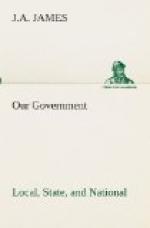7. What buildings has the county at the county seat? Does it own property elsewhere?
8. What process is followed in laying out a new town? in the incorporation of a village?
* * * * *
REFERENCES.
1. The functions of government. Hoxie, How the People Rule, 11-16. Reinsch, Young Citizen’s Reader, 31-46. Dole, Young Citizen, 73-92.
2. Towns and villages. Reinsch, 145-152. Hoxie, 42-63. Hill, Lessons for Junior Citizens, 142-168.
3. County government. Reinsch, 163-166. Hoxie, 90-103.
CHAPTER III
THE ORIGIN OF LOCAL GOVERNMENTS.
The Source of Our Local Governments.—If we look further into the systems of local government which have been described, we shall find facts in the history of their origins which explain many of their details. We shall now see how local government grew in the colonies, for here we have the beginnings of the systems that are in operation to-day.
Everywhere in the colonies the English settlers brought to their new homes the ancient customs of the mother-country. Differences in physical geography, and in the character and motives of the colonists, caused differences in the resulting local governments. This fact is best illustrated by an account of what took place in New England and in Virginia.
The Method of Settlement in New England.—These colonies were settled by emigrants who came, in the main, from the same classes of Englishmen. The New Englanders, however, were Puritans. The church and its services were a very important part of their daily lives. The requirement of church attendance was one reason for grouping their homes near the meeting-house. Moreover, the region in which they settled had a stony soil, difficult to cultivate. Their farms required careful cultivation, and therefore could not be very large. The New Englander was content to live near the coast. Means of traveling to the interior were not easy, for the rivers, with few exceptions, were short and rapid. The sea fisheries tempted the settlers to remain near the coast, and fishing, with ship-building and commerce, became their important industries.
Town Meetings and Officers.—For these reasons New England was a region of small farms and towns, and the local government which grew up was adapted to these conditions. The voters of each town (or township) met annually, or oftener, in “town meeting.” Here their common local affairs were discussed and regulated. The church, the schools, roads, the poor, and many other matters were under the complete control of this meeting, and of the officers elected by the assembled voters. These officers were the selectmen,—which was a board having general supervision of the town affairs,—the clerk, treasurer, assessors, fence viewers, constables, and numerous others.
The County in New England.—Because the people lived in towns and could most easily regulate their affairs through the machinery of town government, they had no counties whatever at first; but these were soon established, though merely for judicial purposes. The governor appointed justices who held court in each county.




